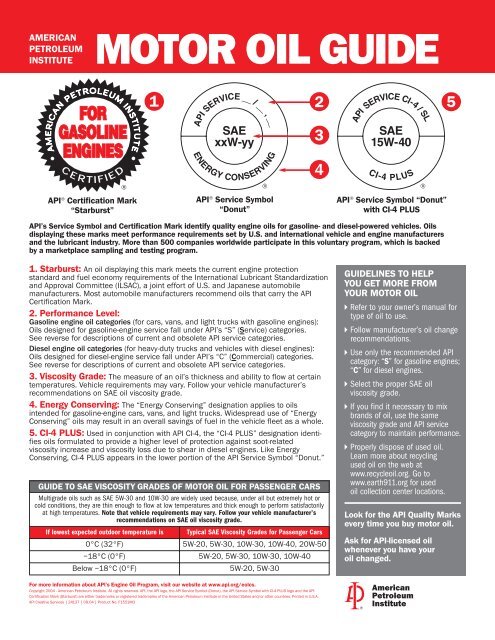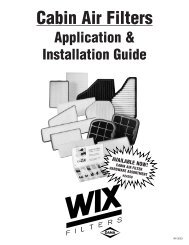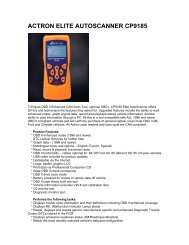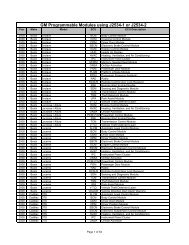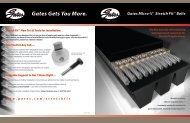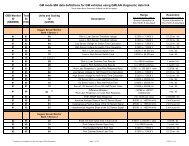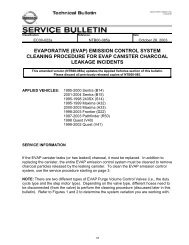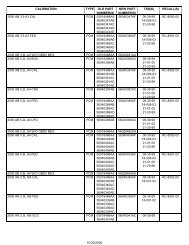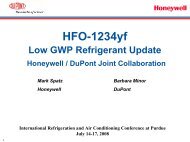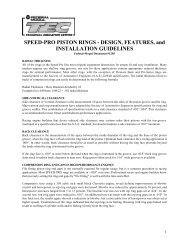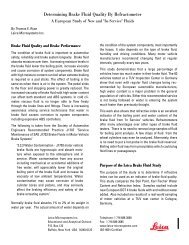MOTOR OIL GUIDE - AA1Car
MOTOR OIL GUIDE - AA1Car
MOTOR OIL GUIDE - AA1Car
You also want an ePaper? Increase the reach of your titles
YUMPU automatically turns print PDFs into web optimized ePapers that Google loves.
AMERICAN<br />
PETROLEUM<br />
INSTITUTE<br />
<strong>MOTOR</strong> <strong>OIL</strong> <strong>GUIDE</strong><br />
®<br />
API® Certification Mark<br />
“Starburst”<br />
1 2<br />
5<br />
API® Service Symbol<br />
“Donut”<br />
API’s Service Symbol and Certification Mark identify quality engine oils for gasoline- and diesel-powered vehicles. Oils<br />
displaying these marks meet performance requirements set by U.S. and international vehicle and engine manufacturers<br />
and the lubricant industry. More than 500 companies worldwide participate in this voluntary program, which is backed<br />
by a marketplace sampling and testing program.<br />
1. Starburst: An oil displaying this mark meets the current engine protection<br />
standard and fuel economy requirements of the International Lubricant Standardization<br />
and Approval Committee (ILSAC), a joint effort of U.S. and Japanese automobile<br />
manufacturers. Most automobile manufacturers recommend oils that carry the API<br />
Certification Mark.<br />
2. Performance Level:<br />
Gasoline engine oil categories (for cars, vans, and light trucks with gasoline engines):<br />
Oils designed for gasoline-engine service fall under API’s “S” (Service) categories.<br />
See reverse for descriptions of current and obsolete API service categories.<br />
Diesel engine oil categories (for heavy-duty trucks and vehicles with diesel engines):<br />
Oils designed for diesel-engine service fall under API’s “C” (Commercial) categories.<br />
See reverse for descriptions of current and obsolete API service categories.<br />
3. Viscosity Grade: The measure of an oil’s thickness and ability to flow at certain<br />
temperatures. Vehicle requirements may vary. Follow your vehicle manufacturer’s<br />
recommendations on SAE oil viscosity grade.<br />
4. Energy Conserving: The “Energy Conserving” designation applies to oils<br />
intended for gasoline-engine cars, vans, and light trucks. Widespread use of “Energy<br />
Conserving” oils may result in an overall savings of fuel in the vehicle fleet as a whole.<br />
5. CI-4 PLUS: Used in conjunction with API CI-4, the “CI-4 PLUS” designation identifies<br />
oils formulated to provide a higher level of protection against soot-related<br />
viscosity increase and viscosity loss due to shear in diesel engines. Like Energy<br />
Conserving, CI-4 PLUS appears in the lower portion of the API Service Symbol “Donut.”<br />
<strong>GUIDE</strong> TO SAE VISCOSITY GRADES OF <strong>MOTOR</strong> <strong>OIL</strong> FOR PASSENGER CARS<br />
Multigrade oils such as SAE 5W-30 and 10W-30 are widely used because, under all but extremely hot or<br />
cold conditions, they are thin enough to flow at low temperatures and thick enough to perform satisfactorily<br />
at high temperatures. Note that vehicle requirements may vary. Follow your vehicle manufacturer’s<br />
recommendations on SAE oil viscosity grade.<br />
If lowest expected outdoor temperature is Typical SAE Viscosity Grades for Passenger Cars<br />
0°C (32°F)<br />
5W-20, 5W-30, 10W-30, 10W-40, 20W-50<br />
–18°C (0°F)<br />
5W-20, 5W-30, 10W-30, 10W-40<br />
Below –18°C (0°F)<br />
5W-20, 5W-30<br />
For more information about API’s Engine Oil Program, visit our website at www.api.org/eolcs.<br />
Copyright 2004 - American Petroleum Institute. All rights reserved. API, the API logo, the API Service Symbol (Donut), the API Service Symbol with CI-4 PLUS logo and the API<br />
Certification Mark (Starburst) are either trademarks or registered trademarks of the American Petroleum Institute in the United States and/or other countries. Printed in U.S.A.<br />
API Creative Services | 24137 | 09.04 | Product No. F1551MO<br />
3<br />
4<br />
® ®<br />
API® Service Symbol “Donut”<br />
with CI-4 PLUS<br />
<strong>GUIDE</strong>LINES TO HELP<br />
YOU GET MORE FROM<br />
YOUR <strong>MOTOR</strong> <strong>OIL</strong><br />
�Refer to your owner’s manual for<br />
type of oil to use.<br />
�Follow manufacturer’s oil change<br />
recommendations.<br />
�Use only the recommended API<br />
category: “S” for gasoline engines;<br />
“C” for diesel engines.<br />
�Select the proper SAE oil<br />
viscosity grade.<br />
�If you find it necessary to mix<br />
brands of oil, use the same<br />
viscosity grade and API service<br />
category to maintain performance.<br />
�Properly dispose of used oil.<br />
Learn more about recycling<br />
used oil on the web at<br />
www.recycleoil.org. Go to<br />
www.earth911.org for used<br />
oil collection center locations.<br />
Look for the API Quality Marks<br />
every time you buy motor oil.<br />
Ask for API-licensed oil<br />
whenever you have your<br />
oil changed.
AMERICAN<br />
PETROLEUM<br />
INSTITUTE<br />
Which oil is right for you?<br />
The current and previous API Service Categories are listed below.<br />
Vehicle owners should refer to their owner’s manuals before<br />
consulting these charts. Oils may have more than one performance<br />
level.<br />
For automotive gasoline engines, the latest engine oil service<br />
category includes the performance properties of each earlier<br />
category. If an automotive owner’s manual calls for an API SJ<br />
or SL oil, an API SM oil will provide full protection. For diesel<br />
engines, the latest category usually – but not always – includes<br />
the performance properties of an earlier category.<br />
Gasoline Engines<br />
Category Status Service<br />
SM<br />
SL<br />
Current<br />
SJ Current<br />
SH Obsolete<br />
SG<br />
SF<br />
SE<br />
Obsolete<br />
Obsolete<br />
Obsolete<br />
SD Obsolete<br />
SC<br />
Obsolete<br />
SB Obsolete<br />
SA Obsolete<br />
<strong>MOTOR</strong> <strong>OIL</strong> <strong>GUIDE</strong><br />
Current<br />
For all automotive engines currently<br />
in use. Introduced November 30, 2004,<br />
SM oils are designed to provide improved<br />
oxidation resistance, improved deposit<br />
protection, better wear protection, and<br />
better low-temperature performance over<br />
the life of the oil. Some SM oils may also<br />
meet the latest ILSAC specification<br />
and/or qualify as Energy Conserving.<br />
For 2004 and older automotive engines.<br />
For 2001 and older automotive engines.<br />
For 1996 and older engines. Valid when<br />
preceded by current C categories.<br />
For 1993 and older engines.<br />
For 1988 and older engines.<br />
CAUTION—Not suitable for use in<br />
gasoline-powered automotive engines<br />
built after 1979.<br />
CAUTION—Not suitable for use in<br />
gasoline-powered automotive engines<br />
built after 1971. Use in more modern<br />
engines may cause unsatisfactory<br />
performance or equipment harm.<br />
CAUTION—Not suitable for use in<br />
gasoline-powered automotive engines<br />
built after 1967. Use in more modern<br />
engines may cause unsatisfactory<br />
performance or equipment harm.<br />
CAUTION—Not suitable for use in<br />
gasoline-powered automotive engines<br />
built after 1963. Use in more modern<br />
engines may cause unsatisfactory<br />
performance or equipment harm.<br />
CAUTION—Contains no additives. Not<br />
suitable for use in gasoline-powered<br />
automotive engines built after 1930.<br />
Use in modern engines may cause<br />
unsatisfactory engine performance<br />
or equipment harm.<br />
Note: API intentionally omitted “SI” and “SK” from the sequence of<br />
categories. For more information about API’s Engine Oil Program, visit<br />
our website at www.api.org/eolcs.<br />
Diesel Engines<br />
Category Status Service<br />
Introduced in 2002. For high-speed, four-stroke<br />
engines designed to meet 2004 exhaust<br />
emission standards implemented in 2002. CI-4<br />
oils are formulated to sustain engine durability<br />
CI-4 Current<br />
where exhaust gas recirculation (EGR) is used<br />
and are intended for use with diesel fuels<br />
ranging in sulfur content up to 0.5% weight.<br />
Can be used in place of CD, CE, CF-4, CG-4,<br />
and CH-4 oils. Some CI-4 oils may also qualify<br />
for the CI-4 PLUS designation.<br />
CH-4 Current<br />
CG-4<br />
CF-4<br />
CF-2<br />
CF<br />
CE Obsolete<br />
CD-II Obsolete<br />
CD<br />
CC<br />
CB<br />
CA<br />
Current<br />
Current<br />
Current<br />
Current<br />
Obsolete<br />
Obsolete<br />
Obsolete<br />
Obsolete<br />
Introduced in 1998. For high-speed, four-stroke<br />
engines designed to meet 1998 exhaust<br />
emission standards. CH-4 oils are specifically<br />
compounded for use with diesel fuels ranging<br />
in sulfur content up to 0.5% weight. Can be<br />
used in place of CD, CE, CF-4, and CG-4 oils.<br />
Introduced in 1995. For severe duty, high-speed,<br />
four-stroke engines using fuel with less than<br />
0.5% weight sulfur. CG-4 oils are required for<br />
engines meeting 1994 emission standards.<br />
Can be used in place of CD, CE, and CF-4 oils.<br />
Introduced in 1990. For high-speed, four-stroke,<br />
naturally aspirated and turbocharged engines.<br />
Can be used in place of CD and CE oils.<br />
Introduced in 1994. For severe duty, two-strokecycle<br />
engines. Can be used in place of CD-II<br />
oils.<br />
Introduced in 1994. For off-road, indirectinjected<br />
and other diesel engines including<br />
those using fuel with over 0.5% weight sulfur.<br />
Can be used in place of CD oils.<br />
Introduced in 1985. For high-speed, four-stroke,<br />
naturally aspirated and turbocharged engines.<br />
Can be used in place of CC and CD oils.<br />
Introduced in 1985. For two-stroke cycle<br />
engines.<br />
Introduced in 1955. For certain naturally<br />
aspirated and turbocharged engines.<br />
CAUTION—Not suitable for use in diesel-powered<br />
engines built after 1990.<br />
CAUTION—Not suitable for use in diesel-powered<br />
engines built after 1961.<br />
CAUTION—Not suitable for use in diesel-powered<br />
engines built after 1959.<br />
Copyright 2004 - American Petroleum Institute. All rights reserved.<br />
API, the API logo, the API Service Symbol (Donut), the API Service<br />
Symbol with CI-4 PLUS logo and the API Certification Mark (Starburst)<br />
are either trademarks or registered trademarks of the American<br />
Petroleum Institute in the United States and/or other countries.<br />
Printed in U.S.A. Creative Services | 24137 | 09.04 | Product No. F1551MO


